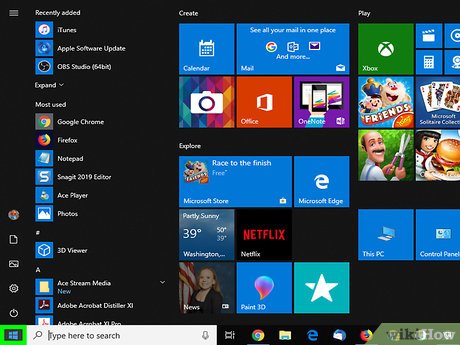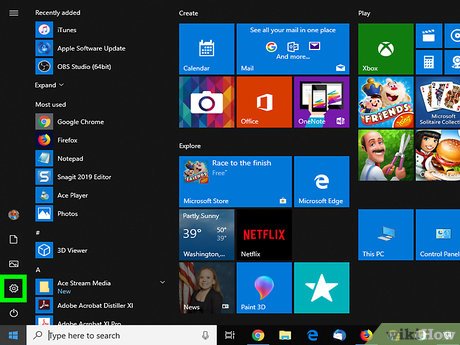How to Find and Update Drivers
This wikiHow teaches you how to update your computer's drivers. Drivers are pieces of software which help your computer connect to hardware items such as speakers, USB drives, and so on. Drivers are typically installed and updated...
Method 1 of 4:
On Windows
-
 Open Start. Click the Windows logo in the bottom-left corner of the screen. The Start menu will pop up.
Open Start. Click the Windows logo in the bottom-left corner of the screen. The Start menu will pop up.
- Windows 10 will handle virtually all of your driver updates through the Windows update utility. This typically happens automatically, but you can check for the latest updates at any time.
-
 Open Settings. Click the gear-shaped icon in the bottom-left corner of the Start menu. This prompts the Settings window to open.
Open Settings. Click the gear-shaped icon in the bottom-left corner of the Start menu. This prompts the Settings window to open.
-
 ClickUpdate & Security. It's in the Settings window.
ClickUpdate & Security. It's in the Settings window.
- If Settings instead loads to a specific menu, first click Home in the upper-left corner of the window.
-
 Click Windows Update. You'll see this in the navigation menu on the left side of the window.
Click Windows Update. You'll see this in the navigation menu on the left side of the window. -
 Click Check for updates. It's at the top of the page. Windows will begin checking for any available updates, including updated drivers.
Click Check for updates. It's at the top of the page. Windows will begin checking for any available updates, including updated drivers.- Depending on how long it has been since you last checked for updates, this process may take several minutes.
-
 Click Install now if necessary. This will appear at the top of the page if updates are available. Clicking it prompts the update files to begin downloading.
Click Install now if necessary. This will appear at the top of the page if updates are available. Clicking it prompts the update files to begin downloading.- Depending on your version of Windows, the updates may begin downloading automatically.
- You may be prompted to reboot after updates are installed.[1]
Method 2 of 4:
On Mac
-
 Open the Apple menu. Click the Apple logo in the top-left corner of the screen. A drop-down menu will appear.
Open the Apple menu. Click the Apple logo in the top-left corner of the screen. A drop-down menu will appear.
- Apple handles all of the driver updates that are released for your Mac hardware.
-
 Click App Store…. It's in the drop-down menu. This will open your Mac's App Store.
Click App Store…. It's in the drop-down menu. This will open your Mac's App Store. -
 Click the Updates tab if necessary. If the App Store doesn't open to the "Updates" tab, click this tab at the top of the App Store window to open it. You should see all pending or available updates, including drivers, listed here.
Click the Updates tab if necessary. If the App Store doesn't open to the "Updates" tab, click this tab at the top of the App Store window to open it. You should see all pending or available updates, including drivers, listed here. -
 Click UPDATE ALL. It's a grey button on the far-right side of the App Store window. This will download all of the available updates.
Click UPDATE ALL. It's a grey button on the far-right side of the App Store window. This will download all of the available updates.- Alternatively, you can click UPDATE to the right of the drivers you want to install to install only the drivers.
-
 Wait for updates to download and install. This may take a few minutes, and your Mac may prompt you to reboot after installing.[2]
Wait for updates to download and install. This may take a few minutes, and your Mac may prompt you to reboot after installing.[2]- If a driver's installation is blocked by your Mac, its developer is probably unsigned. You can verify the installation to allow the driver(s) to install.
Method 3 of 4:
Using the Windows Device Manager
-
 Understand when to use this method. Device Manager allows you to search for Microsoft-approved drivers online, but you should only use Device Manager after using Windows Update to search for driver software. The reason for this is that Windows Update is more likely to find the correct drivers the first time.
Understand when to use this method. Device Manager allows you to search for Microsoft-approved drivers online, but you should only use Device Manager after using Windows Update to search for driver software. The reason for this is that Windows Update is more likely to find the correct drivers the first time. -
 Open Start. Click the Windows logo in the bottom-left corner of the screen.
Open Start. Click the Windows logo in the bottom-left corner of the screen.
- You can also just right-click the Start icon.
-
 Open Device Manager. Type device manager into the Start search box, then click Device Manager at the top of the Start window.
Open Device Manager. Type device manager into the Start search box, then click Device Manager at the top of the Start window.- If you right-clicked the Start icon, click Device Manager in the resulting pop-up menu.
-
 Find the heading for the hardware item you need to update. Scroll through the Device Manager window until you find the hardware category to which your item belongs.
Find the heading for the hardware item you need to update. Scroll through the Device Manager window until you find the hardware category to which your item belongs.- For example, if you're attempting to update the drivers for a Bluetooth item, you would find the "Bluetooth" heading.
-
 Double-click the heading. Doing so expands it to show any connected (or previously connected) items in an indented list below the heading.
Double-click the heading. Doing so expands it to show any connected (or previously connected) items in an indented list below the heading.- If the heading already has an indented list of items below it, skip this step.
-
 Select your hardware item. Click once the name of the hardware item for which you want to update the drivers.
Select your hardware item. Click once the name of the hardware item for which you want to update the drivers.- If you don't see the item here, it isn't installed on your computer. Close Device Manager, plug in or pair the item with your computer, follow any on-screen prompts, and then re-open the item's category in Device Manager before proceeding.
-
 Click the Action tab. It's at the top of the Device Manager window. Doing so prompts a drop-down menu.
Click the Action tab. It's at the top of the Device Manager window. Doing so prompts a drop-down menu. -
 Click Update driver. This is at the top of the drop-down menu. A new window will open.
Click Update driver. This is at the top of the drop-down menu. A new window will open. -
 Click Search automatically for updated driver software. It's in the middle of the new window. Windows will begin searching for drivers for your selected item.
Click Search automatically for updated driver software. It's in the middle of the new window. Windows will begin searching for drivers for your selected item. -
 Follow any installation prompts. If drivers are available, you'll be prompted to install them; depending on the hardware item, you may have to click through a few prompts before the installation will begin.
Follow any installation prompts. If drivers are available, you'll be prompted to install them; depending on the hardware item, you may have to click through a few prompts before the installation will begin.- You may be asked to restart your computer after completing the update process.
- If you receive a message that says "The best drivers for your device are already installed", Windows can't find the correct driver files to use. You can still try installing a driver from the manufacturer's website if you're certain that your hardware item's drivers are outdated.
Method 4 of 4:
Using Manufacturer Driver Files
-
 Determine the hardware you want to update. When installing drivers manually, you'll be downloading the driver files directly from the manufacturer. You'll need to know the manufacturer and the model of the hardware you're trying to update.
Determine the hardware you want to update. When installing drivers manually, you'll be downloading the driver files directly from the manufacturer. You'll need to know the manufacturer and the model of the hardware you're trying to update.- For example, if you own a Razer keyboard, you'll find the drivers on the Razer website.
- If you have a laptop, you can usually find all of the drivers you need from your laptop manufacturer's page.
- You can find the model information in the documentation that came with your hardware. You can also find the model information in Device Manager if Windows was able to recognize it.
-
 Visit the manufacturer's website. Once you've determined what you want to update, you'll need to visit the manufacturer's support site. Below are some of the most common ones. If your manufacturer is not listed here, you can find it with a quick web search:
Visit the manufacturer's website. Once you've determined what you want to update, you'll need to visit the manufacturer's support site. Below are some of the most common ones. If your manufacturer is not listed here, you can find it with a quick web search:- Motherboards
- Gigabyte — gigabyte.com/support-downloads/download-center.aspx?ck=2
- Intel — downloadcenter.intel.com
- MSi — msi.com/service/download/
- ASRock — asrock.com/support/download.asp
- Asus — support.asus.com/download/options.aspx?SLanguage=en&type=1
- Graphics
- NVIDIA — nvidia.com/Download/index.aspx?lang=en-us
- AMD/ATI — support.amd.com/en-us/download
- Laptops
- Dell — dell.com/support/home/us/en/19/Products/laptop?app=drivers
- Gateway — gateway.com/worldwide/support/
- HP — www8.hp.com/us/en/support-drivers.html
- Lenovo — support.lenovo.com/us/en/products?tabName=Downloads
- Toshiba — support.toshiba.com
- Network Cards
- Linksys — linksys.com/us/support/
- Netgear — downloadcenter.netgear.com/
- Realtek — realtek.com.tw/downloads/
- Trendnet — trendnet.com/downloads/
- Optical Drives
- Samsung — samsung.com/us/support/
- Sony — sony.storagesupport.com/models/21
- LG — lg.com/us/support
- LiteOn — us.liteonit.com/us/service-support/download
- Peripherals
- Creative — support.creative.com/welcome.aspx
- Logitech — support.logitech.com/
- Plantronics — plantronics.com/us/category/software/
- Turtle Beach — support.turtlebeach.com/files/
- Motherboards
-
 Find the "Downloads" or "Drivers" section. This process will vary from site to site, but in most cases, you'll find the Drivers or Downloads tab near the top of the main page, though you may first have to select or click Support there.
Find the "Downloads" or "Drivers" section. This process will vary from site to site, but in most cases, you'll find the Drivers or Downloads tab near the top of the main page, though you may first have to select or click Support there.- You may need to scroll all the way down to the bottom of the page and then click Support or Drivers there to open the drivers page.
-
 Download the driver files. Click the name of the driver package or the Download link (or icon) near it to do so.
Download the driver files. Click the name of the driver package or the Download link (or icon) near it to do so.- Many drivers come as installers, or are packaged with software designed for the hardware. Older or less-common items may have drivers in ZIP folder format.
- Sometimes the hardware's accompanying software will be listed separately from the drivers.[3]
-
 Run the drivers' installer. Double-click the downloaded setup file and follow any on-screen prompts. If you downloaded the drivers in a ZIP folder, you will first need to extract them by doing the following:
Run the drivers' installer. Double-click the downloaded setup file and follow any on-screen prompts. If you downloaded the drivers in a ZIP folder, you will first need to extract them by doing the following:- Windows — Double-click the ZIP folder, click the Extract tab, click Extract all, and click Extract when prompted.
- Mac — Double-click the ZIP folder and wait for it to finish extracting.
-
 Verify your drivers on a Mac. If you're on a Mac and you receive an error message when attempting to install a driver, you can fix the error by doing the following:
Verify your drivers on a Mac. If you're on a Mac and you receive an error message when attempting to install a driver, you can fix the error by doing the following:- Click OK on the error message.
- Click the Apple menu , then click System Preferences....

- Click Security & Privacy.
- Click Allow next to the "System software...was blocked from loading" message at the bottom of the window.
- Proceed with installing the drivers (you may need to double-click the drivers' setup file again).
-
 Manually install the drivers on Windows. If the drivers came in a .zip file, you'll need to install them manually. You can do this from the Device Manager:[4]
Manually install the drivers on Windows. If the drivers came in a .zip file, you'll need to install them manually. You can do this from the Device Manager:[4]- Select the hardware item you want to update in Device Manager.
- Click Action.
- Click Update driver.
- Click Browse my computer for driver software when prompted.
- Go to the extracted ZIP folder and click any ".inf" file in the folder while holding down Ctrl.
- Click Open.
3.5 ★ | 2 Vote
You should read it
- How to Install Audio Drivers on Windows XP
- 5 basic ways to update, update drivers for computers
- NVIDIA will stop supporting drivers for 32-bit operating systems from 4/2018
- How to Update Video Card Drivers in Windows
- How to use 3DP Chip to update or install missing drivers for the computer
- What is driver in computer? Drivers are required for the operating system
- How to update genuine automatic drivers for Dell laptops
- Steps to fix corrupted drivers on Windows 10
- Automatically update drivers for Windows with Snappy Driver Installer
- Instructions for finding and downloading drivers for the computer in 3 steps
- The software automatically updates the best Driver for computers
- How to identify and install the correct driver missing for Windows?




































 5 basic ways to update, update drivers for computers
5 basic ways to update, update drivers for computers How to use 3DP Chip to update or install missing drivers for the computer
How to use 3DP Chip to update or install missing drivers for the computer Instructions for finding and downloading drivers for the computer in 3 steps
Instructions for finding and downloading drivers for the computer in 3 steps How to update genuine automatic drivers for Dell laptops
How to update genuine automatic drivers for Dell laptops How to use Driver Talent for free driver updates
How to use Driver Talent for free driver updates Fix old driver duplicate settings on Windows Update
Fix old driver duplicate settings on Windows Update